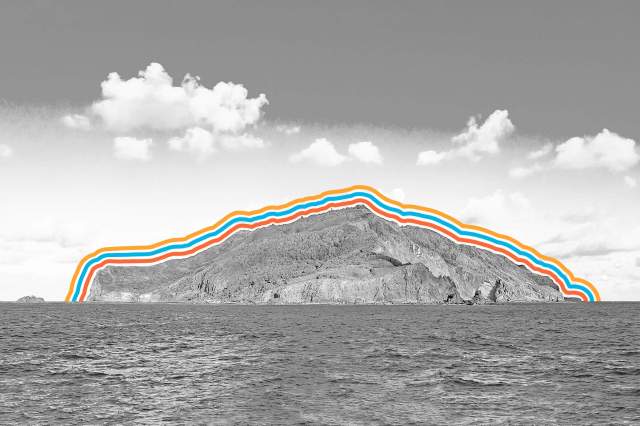
Vulcan Point Is a Tiny Philippine Island in a Nesting Doll of Islands
The island of Luzon is the largest, and arguably the most important, island in the Philippines. It’s home to the archipelagic nation’s capital, Manila, and contains more than half of the country’s population. The island is also home to another unusual island: Vulcan Point, one of the world’s few third-order islands, which means it’s an island inside a lake inside an island inside a lake inside an island, though the story is even slightly more complicated than that.
Vulcan Point is actually a volcanic cone of Taal Volcano, whose caldera (or basin) is where this tiny nesting doll of an island resides. That volcano is surrounded by Taal Lake, which is a popular tourist destination for travelers visiting Taal Volcano National Park. Of course, this lake resides within Luzon, which is itself an island. After Taal Volcano erupted in January 2020, the caldera lake dried up and temporarily disrupted Vulcan Point’s third-order fame, but the waters have since returned.

The Trees on Socotra Island Are Truly Otherworldly
Step ashore on Yemen’s Socotra, 210 miles south of the Arabian Peninsula in the Indian Ocean, and you’ll be greeted by a Seussian landscape unlike any other. Because of its isolation, Socotra is home to a number of endemic species, with around one-third of its plant life unique to this small island. There’s so much biodiversity, the place has been called “the Galapagos of the Indian Ocean,” and it became a UNESCO World Heritage Site in 2008.
The star flora on the island is the distinctive Socotra dragon blood tree (Dracaena cinnabari); its somewhat foreboding name comes from the red sap that oozes from its trunk. Its branches stretch to the sky and form a tightly packed canopy resembling the appearance of an umbrella. Scientists believe the tree’s strange upturned limbs are an arid adaptation so the plant can pull moisture from fog and clouds, a process called horizontal precipitation capture. While the tree struggles against livestock predation, powerful cyclones, and climate change, the island of Socotra is itself caught in the middle of Yemen’s civil war. Despite these hardships, the residents of Socotra are hard at work making sure the island’s unique-yet-vulnerable ecosystem survives for generations to come.

Pitcairn Island Is One of the Most Remote Inhabited Islands in the World
Pitcairn is the only inhabited island of the British Overseas Territory commonly known collectively as the Pitcairn Islands, which also includes Henderson, Ducie, and Oeno islands. At first glance, the island doesn’t look much different from any other small Pacific island, but it does hold an impressive accolade — it’s one of the most remote inhabited islands in the world, being some 1,350 miles southeast of Tahiti, its closest neighbor. The island’s 50 or so residents are descendants of British sailors who famously mutinied aboard the HMS Bounty in 1789. After setting their captain adrift, the mutineers eventually arrived on the island, set fire to their ship, and lived in obscurity before being discovered by American whalers in 1808.
More Interesting Reads

Visitors May Have to Wear Gas Masks on Japan’s Izu Islands
Miyake-jima is a picturesque island that’s part of the Izu archipelago located south of Tokyo. With lush forests and world-class scuba opportunities, Miyake-jima is a vacation hot spot — but the island is also a hot spot of another kind entirely. The Izu Islands are located atop an active volcanic chain, and while eruptions are a concern — volcanoes have erupted in the area six times in the past century — Miyake-jima’s biggest hazard is that it experiences some of the highest concentrations of poisonous gas (mostly sulfur) in the world, due to Mount Oyama, the island’s main volcano. The gas is such a part of everyday life that the island has developed a system of sirens to alert its 2,500 or so inhabitants to quickly don gas masks. When Mount Oyama erupted in 2000, residents needed to evacuate for five years due to the high concentrations of sulfur in the air, and were only allowed to return if they kept gas masks with them at all times. Today, the island is a postcard paradise, but no one knows for sure when Oyama will awake from its slumber.

La Isla de las Muñecas Is Filled With Decomposing Toy Dolls
Islands can be some of the most beautiful places on Earth, or some of the most macabre. Take, for instance, Mexico City’s La Isla de las Muñecas, or “Island of the Dolls.” This island is what’s known as a chinampa, a type of artificial island built up on a wetland, lake, or in this case, a channel located in the district of Xochimilco. Legend has it that 50 years ago, a man named Don Julian Santana Barrera left his family to live on this particular island. Whether a real girl actually drowned in the lake or Don Julian merely imagined it is up for debate, but what isn’t disputed is the strange memorial he constructed in this girl’s memory. Dredging discarded dolls from the river and trading produce for others, the man strung up hundreds of dolls all over the island. Don Julian didn’t attempt to clean or fix these dolls but just strung them up as-is — with arms, eyes, and other body parts damaged or missing. Today, Santana’s creepy memorial remains, and visitors can walk among these discarded dolls after a quick boat ride.

A Distinct Dialect of English Is Spoken on Virginia’s Tangier Island
The U.S. is the proud owner of thousands of islands (Alaska has over 2,600 alone), but one of the most unusual might be Tangier Island, off the coast of Virginia. That’s not because of its curious fauna or endemic flora, but rather the linguistic mystery of its residents. Only 90 miles southeast of the nation’s capital, the island of Tangier is home to its very own blend of American English — a dialect that can sound more British than American.
Linguists theorize that the island largely kept the dialect of its original ancestors, who arrived from Cornwall in the 17th and 18th centuries. As the island was cut off from mainland Virginia, that language then evolved further. Aside from unique pronunciations, the island also has a slew of phrases not found anywhere else in the world, such as “have the meebs” (you’re smelly), “in the sweet peas” (to be asleep), and “you’re hucky” (you’re dirty). Sadly, in the era of climate change, Tangier is slowly sinking amid rising water levels, and experts expect the town will need to be evacuated in the next 50 years.

Runit Island Is Home to a “Nuclear Coffin”
From 1946 to 1958, the U.S. conducted nuclear weapons tests off the coast of the Bikini and Enewetak atolls, in what is now the modern nation of the Marshall Islands. Visit the Pacific island country today, however, and you might not even notice any nuclear scars. That is, except for the 350-foot-wide “nuclear coffin” containing heaps of radioactive debris on Runit Island, part of the Enewetak Atoll. Runit Island is uninhabited and so tiny that the concrete dome of the “coffin” takes up a considerable percentage of its landmass. Around 2020, worries grew that the dome could be leaking radioactive material into the ocean, though some experts say any such leaks are far below the U.S.’s own water-quality standards. Originally built 25 feet above sea level, the dome will need to be constantly monitored as sea levels rise and waves begin to lap against the coffin’s stony exterior.











